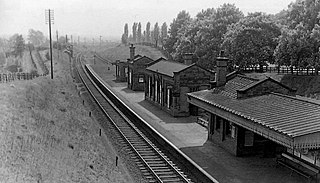
Quorn is a village and civil parish in Leicestershire, England, near the university town of Loughborough. Its name was shortened from Quorndon in 1889, to avoid postal difficulties owing to its similarity to the name of another village, Quarndon, in neighbouring Derbyshire.

Loughborough is a market town in the Charnwood borough of Leicestershire, England, the seat of Charnwood Borough Council and Loughborough University. At the 2021 census the town's built-up area, including Shepshed, had a population of 109,100, the second largest in the county after Leicester. It is close to the Nottinghamshire border and short distances from Leicester, Nottingham, East Midlands Airport and Derby. It has the world's largest bell foundry, John Taylor Bellfounders, which made bells for the Carillon War Memorial, a landmark in the Queens Park in the town, of Great Paul for St Paul's Cathedral, and for York Minster.

The Borough of Charnwood is a local government district with borough status in the north of Leicestershire, England, which has a population of 183,971 as of the 2021 census. It borders Melton to the east, Harborough to the southeast, Leicester and Blaby to the south, Hinckley and Bosworth to the southwest, North West Leicestershire to the west and Rushcliffe in Nottinghamshire to the north. It is named after Charnwood Forest, an area much of which lies within the borough.

The Great Central Railway (GCR) is a heritage railway in Leicestershire, England, named after the company that originally built this stretch of railway. It runs for 8.25 miles (13.28 km) between the town of Loughborough and a new terminus in the north of Leicester. It has period signalling, locomotives and rolling stock.

Shepshed is a market town and civil parish in the Charnwood Borough of Leicestershire, England with a population of 14,875 at the 2021 census. It is the second biggest settlement in the borough, after the town of Loughborough.

Beacon Hill, near Loughborough, in Leicestershire, England, is a popular country park. It is one of several beacon hills in the United Kingdom. It is part of Beacon Hill, Hangingstone and Outwoods Site of Special Scientific Interest.
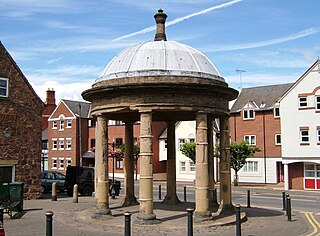
Mountsorrel is a village in Leicestershire on the River Soar, just south of Loughborough with a population in 2001 of 6,662 inhabitants, increasing to 8,223 at the 2011 census.
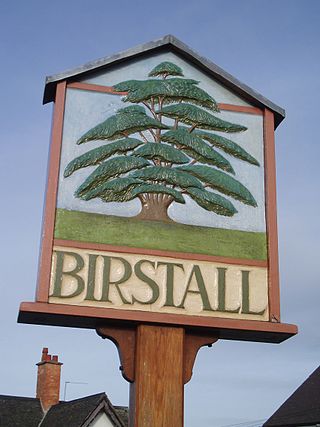
Birstall is a large village and civil parish within the Charnwood borough of Leicestershire, England. It is three miles north of Leicester city centre and is part of the wider Leicester Urban Area.

Newtown Linford is a linear village in Leicestershire, England. The population of the civil parish was 1,000 at the 2001 census, including Ulverscroft, increasing to 1,103 at the 2011 census.
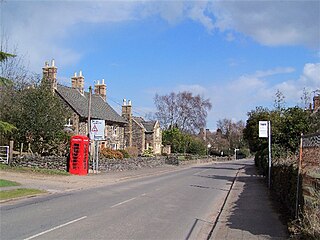
Swithland is a linear village in the Charnwood borough of Leicestershire, England. The civil parish population was put at 230 in 2004 and 217 in the 2011 census. It is in the old Charnwood Forest, between Cropston, Woodhouse and Woodhouse Eaves. It has a village hall, a parish church and a public house, the Griffin Inn. The village is known for the slate that was quarried in the area.

Woodhouse Eaves is a village in Charnwood Forest, Leicestershire, England.
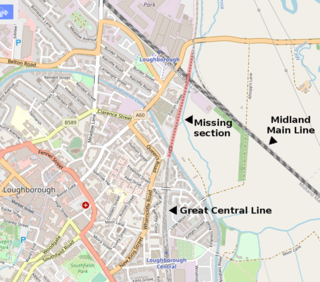
The Loughborough Gap is a 500-metre-long (0.3 mi) missing section of the Great Central Railway to the north-east of Loughborough, England. The gap was created by the removal of embankments and bridges during the 1980s and the restoration project has been branded Bridge to the Future and Bridging the Gap. From south-to-north the route crosses the Grand Union Canal, Railway Terrace road, a Factory car park, four-track Midland Main Line at Loughborough railway station and the A60 road. The Hermitage Brook watercourse runs parallel.

Barrow upon Soar is a large village in northern Leicestershire, in the Soar Valley between Leicester and Loughborough, with a population at the 2011 census of 5,856.

Loughborough railway station is a Grade II listed railway station in the town of Loughborough, Leicestershire, on the Midland Main Line, 111 miles (179 km) north of London St Pancras. The station is north-east of the town centre.
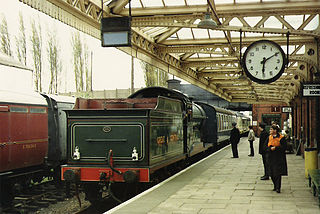
Loughborough Central Station is a railway station on the Great Central Railway and the Great Central Railway (preserved) serving Loughborough.

Rothley railway station is a heritage railway station on the preserved section of the Great Central Railway's London Extension. Built to the standard island platform pattern of country stations on the line, it originally opened on 15 March 1899 and has been restored to late Edwardian era condition, circa 1910.
The Charnwood Forest Railway was a branch line in Leicestershire constructed by the Charnwood Forest Company between 1881 and 1883. The branch line ran from Coalville to the town of Loughborough.

Swithland Reservoir is a reservoir in the English county of Leicestershire. It is north-east of the village of Swithland from which it takes its name, north-west of Rothley and approximately 133 metres (145 yd) south-west of Mountsorrel Quarry. It is part of the 187.1-hectare (462-acre) Buddon Wood and Swithland Reservoir Site of Special Scientific Interest (SSSI).

Junee railway station is a heritage-listed railway station located on the Main South line in New South Wales, Australia. It serves the town of Junee in the Junee Shire. It was added to the New South Wales State Heritage Register on 2 April 1999.
















